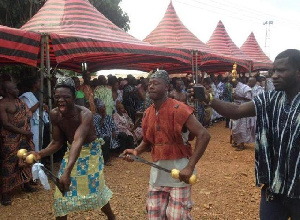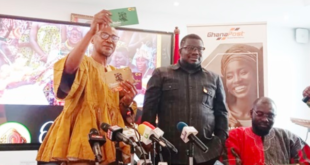The Mo/Dega communities celebrate the ‘Pea dii’ eating of yams festival at different periods by each community, that’s some places of Kintampo. This harvest festival starts in the middle of July and runs to the end of September.
Mostly, it is usually celebrated in August when new yams are ready for harvesting. Before the festival commences, yams are offered to Longoro Teo, a state deity. This is to pave way for the celebration and to take away all the curses that would have come upon anyone who ate yams in the area before the festival.
Appreciation is also expressed to ‘Korowii” the Supreme-being/God and the “Voga” earth Deities in Dega. The first ritual performance of the festival is called Gbandawu, where ritual items such as ashes of burnt tree roots and some spices are mixed with yam and meat and boiled into porridge form. This is offered to Afafu, an earth deity, and the rest is eaten by those who are believed to be spiritually powerful. The food is eaten while still boiling on fire and people eat it to demonstrate the potency of their spiritual powers. The second ritual is called the “Saga” hanging of yams which enables the Mo/Dega to eat the new yam.
Sometimes the crop may not be ready for harvesting by August due to climatic changes. In such instances, the celebration is held in October. The yam that is offered to Longoro Teo is harvested by pulling the vines together with the tuber. If in the process of harvesting, the vines break off from the tuber, it means the yams are not ready, hence the festival cannot be held in August.
However, if the tuber comes out with the vines, it means that the Gods have given the green light for commencement of the festival throughout the traditional area. When the green light is given for the commencement of the festival, it means people in the traditional area can enjoy their yams except for the chiefs. The chiefs can only eat the fresh yams only when the festival has been held.
A day to the D–day, farmers harvest yams for the next day’s event. When the yams get home, a great excitement develops among the people as both children and adults keep shouting ‘tooru’ meaning hurray!. That connotes that the new yam has come to drive away hunger.
On the morning of the festival, talking drums are beaten to herald the coming of the new yams. Libation is then poured to thank the gods and ancestors for their protection and guidance. After the libation, mashed yams mixed with salt and shea butter is sprinkled in the chief’s palace. According to elders, the sprinkling of mashed yam is a way of feeding the gods and ancestors. It is after this sacrifice, that everyone can enjoy the new yams. Families then slaughter livestock or fowls to prepare delicacies with the new yams. The main dish that the majority of the household prepare on this occasion is fufu.
In the afternoon when the people are well-fed, a durbar is organised whereby traditional dances are put up. A number of competitions are organised. These include cycling and wrestling. Fundraising is often organised at the durbar to fund specific projects earmarked in selected communities of the traditional area.
The festival is important for the Mo people because it is a period of stocktaking and family reunion. It is also a period that the youth learn more about their culture, customs, and traditions as well as manners that seek to make them responsible citizens.
The festival is also a period where the Dega version of the proverbial Ghanaian hospitality is demonstrated. This is done by way of support for the aged, widows, orphans, and the neglected in society as yams are shared among all these categories of people.
Reference
Anane–Agyei, N.A–K. (2012) Ghana’s Brong Ahafo Region: The story of African society in the heart of the world.
Source: Kwadwo Ye-Large
 Home Of Ghana News Ghana News, Entertainment And More
Home Of Ghana News Ghana News, Entertainment And More





